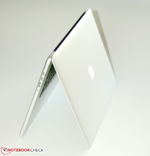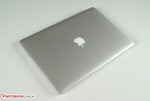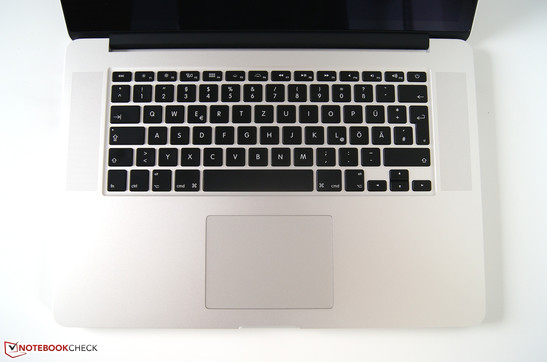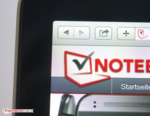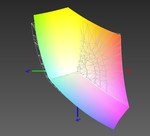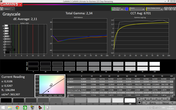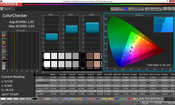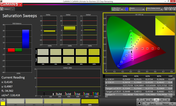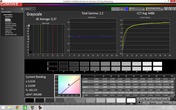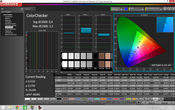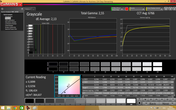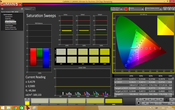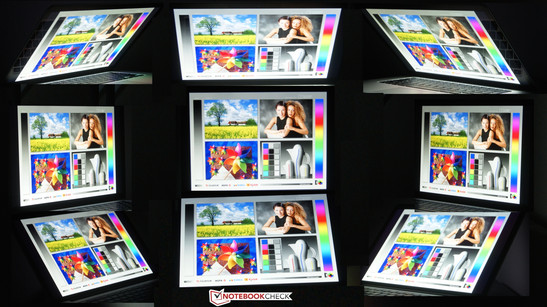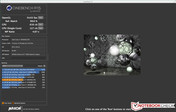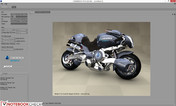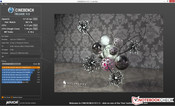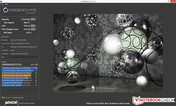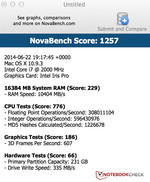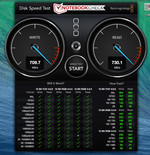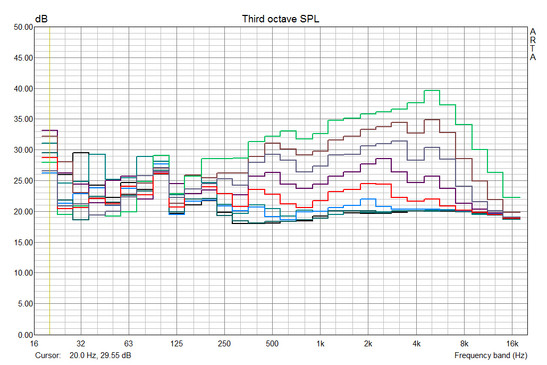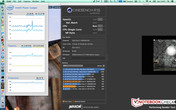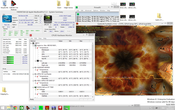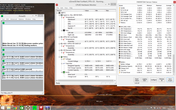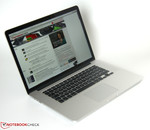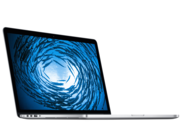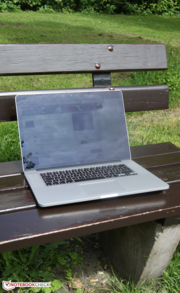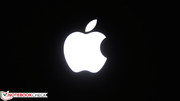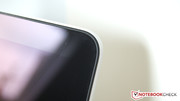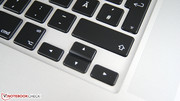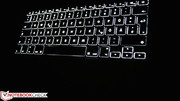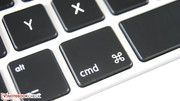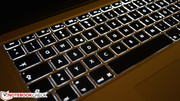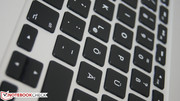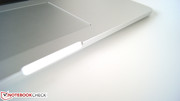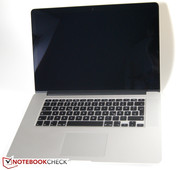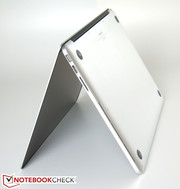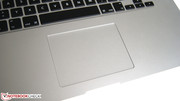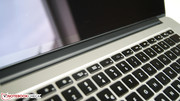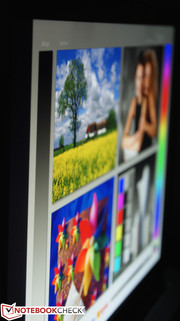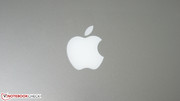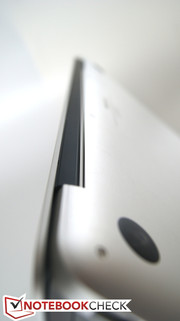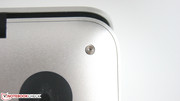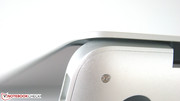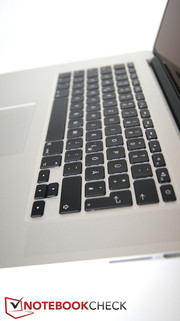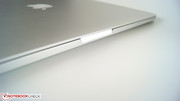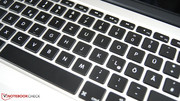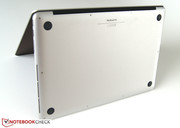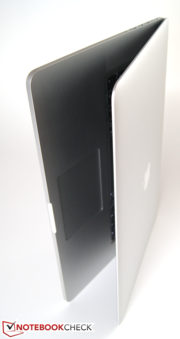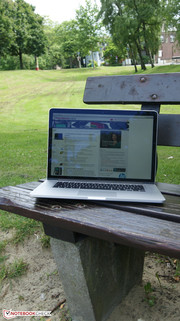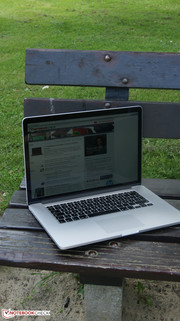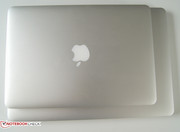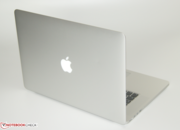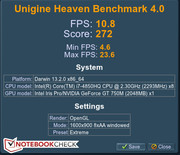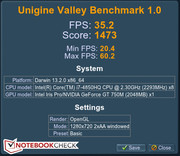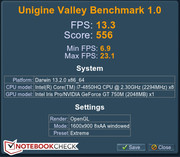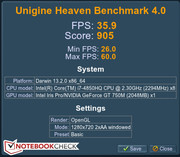Apple MacBook Pro Retina 15 Late 2013 Notebook Review

For the original German review, see here.
With the introduction of the Retina-series in 2012, which was equipped with an IPS panel and 2880x1800 pixels, Apple was the first company to integrate ultra high-resolution displays in this notebook category. Thanks to its pixel density of 220 DPI, the human eye could not see individual pixels. The first models with this IPS display had issues with ghosting, but that was fixed very quickly. The price for such a notebook is still very high. However, fans of Mac OS and the Retina resolution can be happy about a positive price development. The cheapest MacBook from this series is currently available for around 2,000 Euros (~$2722), which is 300 Euros (~$408) less compared to the first Retina version from 2012. Our review unit differs from the entry-level configuration with a dedicated Nvidia GeForce GT 750M graphics card, twice the amount of flash storage (512 GB) and memory (16 GB) as well as a more powerful Intel Core i7-4850HQ CPU clocked at 2.3 GHz. Thanks to the combination of performance, a sturdy aluminum case and the comparatively low weight, it qualifies for multimedia purposes.
However, the competition does not sleep. We will use notebooks from several price ranges for a comparison with the MacBook Pro Retina. For starters, there is the Dell XPS 15 (Late 2013) for around 2,060 Euros (~$2803), which is also equipped with an Nvidia GeForce GT 750M and a slightly less powerful Intel Core i7-4702 CPU. However, it has a higher-resolution touch display with 3200x1800 pixels. Significantly less expensive is the Samsung ATIV Book 8 that uses a standard Full HD display, the similar GPU and an Intel Core i7-4700HQ for 1,300 Euros (~$1769). 300 Euros (~$408) cheaper than the Samsung is Acer's Aspire R7-571G that offers a high-quality IPS panel and multi-touch support.
We are talking about notebooks with graphics cards based on Nvidia's Kepler architecture, which was already replaced by the Maxwell architecture in March 2014, so there is probably going to be an update from Apple and other manufacturers soon. Therefore, we will also use the Asus N550JK and evaluate the performance of the new Nvidia GeForce GT 850M.
Case
The case is manufactured from a single piece of aluminum and this did not change compared to the first Retina model. It can still convince us with its sturdiness and the perfect build quality; only the front edge of the case is somewhat sharp at the corners and was not reworked for this version. Overall, the aluminum leaves a dignified impression and also feels splendid. With a measured weight of 2,012 g (~4.4 pounds), the MacBook is a lightweight in this category of multimedia notebooks. The formerly mentioned Samsung ATIV Book 8 and Acer Aspire R7-571G are noticeably heavier than the Apple notebook weighing 2.4 and 2.5 kg (~5.3 and 5.5 pounds). The Dell on the other hand is on a similar level in terms of weight and dimensions; both notebooks are similarly thin measuring 18 mm (~0.7 inches). The keyboard and trackpad layout of the two devices is very similar as well.
You can open the base unit when you loosen five Pentalobe screws, but all you can do is look at the components, you cannot actually maintain anything. Similar to all Retina models you can neither remove nor replace the battery. This is not necessarily the price of the slim chassis when you look at the Dell XPS 15, which gives you access to all of the important components at this point.
Connectivity
Nothing really changed in this category at a first look, either. The port variety of the MacBook Pro with two USB 3.0 ports is pretty meager, but in return you get the new Thunderbolt port with a transfer rate of up to 20 Gbps. Thanks to the combination of the PCIe and USB architecture you can use Thunderbolt adaptors for pretty much everything. The problem with this is the high price of the corresponding adaptors. Apple offers optional Thunderbolt adaptors when you buy the notebook.
A new feature is the maximum resolution for external displays. You can now drive panels with up to 4096x2160 pixels at 24 Hz via HDMI and 3840x2160 pixels at 30 Hz via Thunderbolt. Only the MacBook Pro Retina 15 as well as the Mac Pro support 60 Hz displays with Multi Stream Transport (MST).
The port layout is convenient in the rear area of the notebook, so there will not be any issues with attached cables. The problem with a slim 18 mm case is that thicker and protruding USB sticks can lift the notebook, which we noticed in the review of the 13-inch version.
Communication
While the predecessor supported the IEEE 802.11n standard, the new model is equipped with an 802.11ac module. The completely subjective performance during normal web browsing and downloading appears very smooth and fast. The test with iperf uses the Apple MacBook Pro Retina 13 from the same series of our review unit. The router was one floor above the review units and we determined a reasonably constant transfer rate of 50 Mbps.
Accessories
Apple does not only save money on the box, but also in terms of accessories. Neither an Ethernet nor a VGA/DVI adaptor is provided. Apart from a microfiber cloth and the extension cord for the MagSafe 2 you do not get anything. The optional adaptors are available for 30 Euros (~$41).
Maintenance
We already mentioned the bad maintainability of the Retina-series because of non-removable components in the Case section. Our colleagues from iFixit only rate the notebook with 1 of 10 possible points as a result.
Warranty
As usual for Apple devices, you just get a one-year manufacturer's warranty with all support features after the purchase. An extension of this service retails for a hefty price of 350 Euros (~$476) and includes the support for all questions in terms of hardware and software.
Input Devices
Keyboard
The black chiclet keyboard with a 16-stage background illumination can convince us in every respect with precise pressure points and convenient feedback. Clattering noise from the keys is minimal, which results in a pleasant noise during typing. The keyboards of all MacBooks are similar, so there are no size differences between the 13-inch and 15-inch MacBook. Unfortunately, this also means there are no special keys or shortcuts, even though the space is available. Instead of special keys, you get microphone and speaker grills on both sides of the keyboard.
Touchpad
Apple is essentially the pioneer concerning the trackpad when you are looking for a mouse replacement and multi-touch. Gestures like wiping or zooming are very smooth and no problem with up to four fingers. The trackpad reacts very precisely and directly. We could not determine any issues in the peripheral areas, either. Primary and secondary clicks can either be executed with one and two-finger taps, respectively, or in the lower corners with a mechanical feedback. All in all the glass trackpad can still convince us and allows, depending on the scenario, a similar working speed as with an external mouse. Under Windows via Boot Camp, you cannot use most multi-touch gestures and the overall operation is noticeably slower compared to Mac OS. Unfortunately, there are no settings for the gestures at all.
Display
Apple still uses a high-quality IPS panel with a maximum resolution of 2880x1800 pixels. The display got more anti-reflective over the years, which is actually clearly visible with light sources from behind. However, this is still a glossy display, which results in brilliant colors, but it creates problems in certain environments. The first versions of the Retina model used an IPS panel from LG, which had issues with ghosting where objects burned into the display. This is fortunately not the case anymore.
The comparison between Windows and Mac OS still shows that the high resolution creates compatibility problems under Windows. Application windows, symbols and some games have scaling issues. Some buttons can easily disappear in deformed windows. High resolutions have become established under Mac OS by now. Applications and symbols are displayed without visible pixels and without issues. Most manufacturers also updated their software with high resolutions since the introduction of the Retina-series, so there are no problems during operation.
| |||||||||||||||||||||||||
Brightness Distribution: 83 %
Contrast: 998:1 (Black: 0.3326 cd/m²)
ΔE ColorChecker Calman: 1.95 | ∀{0.5-29.43 Ø4.77}
ΔE Greyscale Calman: 2.11 | ∀{0.09-98 Ø5}
60.6% AdobeRGB 1998 (Argyll 1.6.3 3D)
Gamma: 2.34
CCT: 6489 K
The presentation under Windows and Mac OS can vary due to the use of different color profiles. Under Mac OS we can measure a contrast of 998:1 and an almost perfect color temperature of 6,489 K. The resulting black value of 0.33 cd/m² appears very natural and is better than the average of multimedia notebooks. This means the MacBook manages much better results than the IPS panel of the Dell XPS 15, for instance. However, the MacBook Retina is clearly beaten in terms of maximum brightness. The Dell manages an unbelievable 440 cd/m² and therefore 110 cd/m² more than the Apple notebook. Compared to the Acer R7, the MacBook falls behind in the contrast and black value. A contrast of almost 1,100:1 and a slightly lower average brightness of 286.7 cd/m² result in an even better black value of 0.28 cd/m².
The presentation under Windows and Mac OS can vary due to the use of different color profiles. Under Mac OS we can measure a contrast of 998:1 and an almost perfect color temperature of 6,489 K. The resulting black value of 0.33 cd/m² appears very natural and is better than the average of multimedia notebooks. This means the MacBook manages much better results than the IPS panel of the Dell XPS 15, for instance. However, the MacBook Retina is clearly beaten in terms of maximum brightness. The Dell manages an unbelievable 440 cd/m² and therefore 110 cd/m² more than the Apple notebook. Compared to the Acer R7, the MacBook falls behind in the contrast and black value. A contrast of almost 1,100:1 and a slightly lower average brightness of 286.7 cd/m² result in an even better black value of 0.28 cd/m².
The analysis of the color presentation reveals above-average results. Multimedia notebooks from the last couple of years had an average DeltaE deviation of 9 for the grayscale. The MacBook clearly beats this result even without calibration: Grayscale DeltaE of 2.11. This result is similar for the colors with a DeltaE deviation of 1.95, which is once again clearly below the average of 8.3. We can actually see almost perfect values close to zero after the calibration (CalMAN, compared to sRGB).
Even though the Apple display is anti-reflective for direct light sources, it is still far away from a matte panel. The contrast and the brightness are sufficient to work in the shade. However, you should look for an alternative if you frequently work outdoors, especially in brighter environments, since Apple waived the matte display option with the launch of the Retina-series. One of these alternatives would be the rival Samsung ATIV Book 8, which has a display with a similar contrast and brightness, but only the Full HD resolution.
Thanks to the IPS display, the viewing angle stability is perfect in any direction. Colors and the brightness are hardly distorted, or not at all. Even extreme angles from the sides are no problem for the display. The maximum opening angle could be a bit bigger, but it is sufficient for use on your lap.
Performance
The 15-inch Retina-series is divided into two sub categories. One with an integrated graphics card, and the other with an additional dedicated graphics card from Nvidia. Our review unit is from the second category and represents the "cheapest" version at 2,600 Euros (~$3538).
| MacBook Pro Retina 15 | Configuration I | Configuration II |
|---|---|---|
| CPU | Intel Core i7-4750HQ | - |
| Intel Core i7-4850HQ (+ 100 Euros) | Intel Core i7-4850HQ | |
| Intel Core i7-4960HQ (+ 300 Euros) | Intel Core i7-4960HQ (+ 200 Euros) | |
| GPU (integrated) | Intel Iris Pro | Intel Iris Pro |
| GPU (dedicated) | - | Nvidia GeForce GT 750M |
| Memory | 8 GB | - |
| 16 GB (+ 200 Euros) | 16 GB | |
| Storage (SSD) | 256 GB | - |
| 512 GB (+ 300 Euros) | 512 GB | |
| 1 TB (+ 800 Euros) | 1 TB (+ 500 Euros) | |
| Base Price | 1,999 Euros | 2,599 Euros |
Processor
The Intel Core i7-4850HQ is a high-end notebook CPU with its four cores and a nominal clock of 2.3 GHz. Intel specifies the maximum Turbo Boost with 3.5 GHz and a TDP of 47 Watts, which is similar to the CPU of the Samsung ATIV 8, but higher than the 37 Watts chip inside the Dell XPS and also higher than the 17 Watts of the Acer processor. We will check the effect on the battery runtimes later in this review.
Now we compare and analyze the benchmark results. The Cinebench benchmarks show that there is no appreciable performance difference between Windows and Mac OS. The small differences are a result of the variance of these benchmarks. The MacBook does not have an advantage over its rivals, but it is on the same level. The Samsung ATIV Book 8 has a small advantage in Cinebench R15 as well as R11.5, despite the slightly less powerful CPU. The Acer Aspire R7-571G only manages 60 % of the points in Cinebench R11.5 because of the ULV architecture of the CPU.
We could not determine any throttling under Mac OS, despite our continuous stress test with a Terminal process, a Cinebench loop and the Unigine benchmark. The Turbo Boost is immediately activated again as soon as the CPU cooled down after a period at the nominal clock. It seems that the utilization of the Turbo is good, but the average temperature of the CPU under continuous load is pretty high at 90 °C (194 °F). The throttling behavior changes dramatically under Windows. The clock is 500 MHz under the base frequency in our stress test with Prime95 and FurMark. The CPU temperature is lower at 83 °C (181.4 °F) on average because of the throttling.
The CPU performance is not affected on battery power according to the Multi-Core test of Cinebench R15 and the results do not differ from mains power. There were significant differences in the Single-Core test, where we got 97 instead of 133 points (-28%).
| Cinebench R11.5 | |
| CPU Single 64Bit (sort by value) | |
| Apple MacBook Pro Retina 15 inch 2013-10 | |
| Apple MacBook Pro Retina 15 inch 2012-06 | |
| Dell XPS 15 (Late 2013) | |
| Samsung 870Z5G | |
| Acer Aspire R7-571G-53338G75ass | |
| Apple MacBook Pro Retina 13 inch 2013-10 | |
| Asus N550JV-CN201H | |
| Asus N550JK-CN109H | |
| CPU Multi 64Bit (sort by value) | |
| Apple MacBook Pro Retina 15 inch 2013-10 | |
| Apple MacBook Pro Retina 15 inch 2012-06 | |
| Dell XPS 15 (Late 2013) | |
| Samsung 870Z5G | |
| Acer Aspire R7-571G-53338G75ass | |
| Apple MacBook Pro Retina 13 inch 2013-10 | |
| Asus N550JV-CN201H | |
| Asus N550JK-CN109H | |
| Cinebench R15 | |
| CPU Single 64Bit (sort by value) | |
| Apple MacBook Pro Retina 15 inch 2013-10 | |
| Samsung 870Z5G | |
| Apple MacBook Pro Retina 13 inch 2013-10 | |
| Asus N550JK-CN109H | |
| CPU Multi 64Bit (sort by value) | |
| Apple MacBook Pro Retina 15 inch 2013-10 | |
| Samsung 870Z5G | |
| Apple MacBook Pro Retina 13 inch 2013-10 | |
| Asus N550JK-CN109H | |
System Performance
What can you say about the system performance of a notebook with a high-end CPU and a fast SSD? Subjectively, the system performance and the reaction times in particular are very fast. This is also confirmed by the PCMark 7 score under Windows. With 5,842 points, the MacBook is pretty much on the same level with the Dell XPS 15 and the first Retina from 2012 is also pretty close with 5,545 points. The slowest device is the Samsung ATIV Book 8 with less than half of the points from the Apple MacBook Pro Retina because of the slow conventional hard drive.
Under Mac OS, we test and compare the benchmarks of the website OpenBenchmark.org. The test suite consists of applications that stress the CPU as well as the GPU. The MacBook Pro Retina 15 has a clear advantage over its smaller 13-inch sibling. The CPU of the reviewed 13-inch version is an Intel Core i5-4258U dual-core processor. Depending on the test environment, we can see advantages between 20 and 70%. Especially impressive is the OpenSSL test, where the 15-inch MacBook gets roughly three times the points. The differences are even bigger compared to the MacBook Air. Another interesting aspect is the comparison with the Dell S413, which ran this test suite under Ubuntu. Thanks to the Intel Core i7-4750HQ, it is a real rival in terms of CPU performance, but it is beaten in the majority of tests.
| PCMark 7 Score | 5842 points | |
| PCMark 8 Home Score Accelerated | 3245 points | |
| PCMark 8 Creative Score Accelerated | 3307 points | |
| PCMark 8 Work Score Accelerated | 4012 points | |
Help | ||
Storage Devices
One reason for the high system performance of the MacBook is the integrated storage solution. Similar to the MacBook Pro Retina 13 you now get a faster PCIe interface instead of SATA. With transfer rates of around 730 MB/s (reading) and 600 MB/s (writing) under Windows and up to 700 MB/s under Mac OS, the storage is extremely fast. The Dell XPS 15 falls behind by up to 200 MB/s compared to the Apple notebook. Far behind are the Acer Aspire R7-571G and Samsung ATIV Book 8 with their conventional hard drives. However, the situation changes in the 4K test, where the MacBook only manages half of the Dell in the AS SSD benchmark with 15.56 MB/s (read) and 27.86 MB/s (write). We know this problem since the change to the PCIe interface.
Graphics
Because of the Intel Core i7-4850HQ CPU, our Apple MacBook Retina has two graphics cards: The integrated Intel Iris Pro 5200 Graphics for basic and less demanding tasks and the Nvidia GeForce GT 750M, which offers the compromise of good performance and compact dimensions of a dedicated graphics card. The Nvidia GPU is familiar since it is used for many multimedia notebooks. The Kepler architecture of the Nvidia GeForce GT 750M was replaced by the Maxwell architecture of the new Nvidia 800-series. Apple will probably use the new Nvidia chips in the upcoming MacBook-series.
Our GT 750M uses 2 GB GDDR5 memory instead of the popular DDR3 memory. This means the GPU of our review unit uses the maximum amount of memory, so the GPU should have an advantage over other versions of this chip in the benchmarks. We will also use the Asus N550JK, which is equipped with a new Nvidia GeForce GT 850M, for the comparison.
We can see a dynamic switching of the two graphics cards under Mac OS X Mavericks depending on the application. This is not the case for the Windows installation via Boot Camp, the Device Manager only shows the Nvidia GT 750M. This also means that the power consumption under Windows will be much higher because the switchable graphics does not work, and that the battery runtimes are shorter compared to Mac OS.
| 3DMark 11 - 1280x720 Performance (sort by value) | |
| Apple MacBook Pro Retina 15 inch 2013-10 | |
| Apple MacBook Pro Retina 13 inch 2013-10 | |
| Apple MacBook Pro Retina 15 inch 2012-06 | |
| Dell XPS 15 (Late 2013) | |
| Samsung 870Z5G | |
| Asus N550JK-CN109H | |
| 3DMark 06 Standard Score | 15845 points | |
| 3DMark Vantage P Result | 11504 points | |
| 3DMark 11 Performance | 2692 points | |
| 3DMark Ice Storm Standard Score | 72048 points | |
| 3DMark Cloud Gate Standard Score | 10275 points | |
| 3DMark Fire Strike Score | 1800 points | |
Help | ||
Gaming Performance
The variety of games under Mac OS was improved significantly over the last couple of years, thanks to services like Steam and Origin. Still, most games are just ports that usually result in lower performance. We managed around 60 fps with Tomb Raider on the lowest settings, which is roughly half of the frame rate that we measured under Windows.
As a result, we focus on Windows in terms of gaming and test some interesting titles. The most current games can be played smoothly with medium or even high details. For instance, Titanfall that was released this year runs with 43 fps and high settings. Wolfenstein was no problem either with 60 fps and medium details. Compared to its rivals, the MacBook is usually on the same level or even a bit faster. Only the Dell XPS 15 manages a few more frames per second in almost every title.
The comparison with the new 800-series is interesting and, as we already assumed, it offers significantly more performance. The very complex game Company of Heroes 2 can be played with 37.5 fps on the Asus N550JK and therefore 10 fps more with medium details. We recommend our FAQ section "Computer Games on Laptop Graphics Cards" for a comparison with other graphics cards.
| Tomb Raider | |
| 1366x768 Normal Preset AA:FX AF:4x (sort by value) | |
| Apple MacBook Pro Retina 15 inch 2013-10 | |
| Dell XPS 15 (Late 2013) | |
| Acer Aspire R7-571G-53338G75ass | |
| Asus N550JV-CN201H | |
| 1366x768 High Preset AA:FX AF:8x (sort by value) | |
| Apple MacBook Pro Retina 15 inch 2013-10 | |
| Dell XPS 15 (Late 2013) | |
| Acer Aspire R7-571G-53338G75ass | |
| Asus N550JV-CN201H | |
| BioShock Infinite | |
| 1366x768 Medium Preset (sort by value) | |
| Apple MacBook Pro Retina 15 inch 2013-10 | |
| Dell XPS 15 (Late 2013) | |
| Samsung 870Z5G | |
| 1366x768 High Preset (sort by value) | |
| Apple MacBook Pro Retina 15 inch 2013-10 | |
| Dell XPS 15 (Late 2013) | |
| Samsung 870Z5G | |
| Metro: Last Light | |
| 1366x768 Medium (DX10) AF:4x (sort by value) | |
| Apple MacBook Pro Retina 15 inch 2013-10 | |
| Samsung 870Z5G | |
| Acer Aspire R7-571G-53338G75ass | |
| Acer Aspire R7-571G-53338G75ass | |
| Asus N550JV-CN201H | |
| 1366x768 High (DX11) AF:16x (sort by value) | |
| Apple MacBook Pro Retina 15 inch 2013-10 | |
| Samsung 870Z5G | |
| Acer Aspire R7-571G-53338G75ass | |
| Acer Aspire R7-571G-53338G75ass | |
| Asus N550JV-CN201H | |
| Company of Heroes 2 | |
| 1366x768 Medium AA:Off (sort by value) | |
| Apple MacBook Pro Retina 15 inch 2013-10 | |
| Dell XPS 15 (Late 2013) | |
| Samsung 870Z5G | |
| Asus N550JK-CN109H | |
| 1366x768 High AA:Medium (sort by value) | |
| Apple MacBook Pro Retina 15 inch 2013-10 | |
| Dell XPS 15 (Late 2013) | |
| Samsung 870Z5G | |
| Asus N550JK-CN109H | |
| low | med. | high | ultra | |
|---|---|---|---|---|
| Tomb Raider (2013) | 141.7 | 79.8 | 56.6 | 23.5 |
| BioShock Infinite (2013) | 81.7 | 68.4 | 59.8 | 21.9 |
| Metro: Last Light (2013) | 67.9 | 53.3 | 28.3 | 14.13 |
| Company of Heroes 2 (2013) | 31.3 | 25.6 | 15.6 | 6.9 |
| Titanfall (2014) | 60 | 52.7 | 42.8 | 25.5 |
| Wolfenstein: The New Order (2014) | 59.9 | 59.8 | 28.1 | 28.6 |
Emissions
System Noise
The MacBook Pro Retina is quiet, very quiet. We can hardly hear anything during idle and with light workloads like office tasks. This impression is confirmed by our measurements. As soon as you stress the Apple device, the fans slowly start to increase their rpm levels. The resulting noise is, however, always pleasant and does not include any annoying frequencies. The notebook stays very quiet under Mac OS thanks to the activated switchable graphics and the sophisticated fan control. We can see that the rpm level of the fans always slowly increases to the maximum level under Windows, even with light workloads. In this load scenario or with the maximum rpm level of the fans, respectively, we can measure 35.8 dB(A) on average, which is around 7 dB(A) quieter than the Dell XPS 15, but it can also be significantly louder with up to 45.8 dB(A).
The following picture shows the noise characteristics of the MacBook Pro 15 Retina 2013 in our review configuration. Both fans are spinning at 2000 rpm while idling. While a slight rpm increase (dark green: 2500 rpm/1.6 Sone, blue: 3000 rpm/1.7 Sone) hardly results in more noise, the noise characteristics are shifted towards higher frequencies with an increased system noise up to the maximum (6.0 Sone).
Noise level
| Idle |
| 28 / 28 / 28 dB(A) |
| Load |
| 35.8 / 45.8 dB(A) |
 | ||
30 dB silent 40 dB(A) audible 50 dB(A) loud |
||
min: | ||
Temperature
Aluminum has the advantage of a stylish design and the distribution of local hot spots. The problem is that this material warms up somewhat quickly and, because of the thin construction of the device, it can result in unpleasant temperatures. Especially striking is that the hot spot of the heat development is on top of the keyboard. However, the Dell XPS 15, which has even bigger cooling issues with its 18 mm (~0.7 in) thin chassis, shows that this problem is not limited to Apple devices. Dell's hot spot of 64.6 °C (148.28 °F) is at the bottom, but the 46 °C (114.8 °F) at the top of the MacBook is slightly surpassed by the XPS as well. Still, the heat development is subjectively always fine in practice.
Our stress test with Prime95 and FurMark shows that the CPU in particular reaches very high temperatures, close to 100 °C (212 °F). As we mentioned in the Processor section, we can see a drop below the nominal clock under Windows, but not under Mac OS. A 3DMark 06 run after the stress test did not show any restrictions and resulted in 16,003 points.
(-) The maximum temperature on the upper side is 46 °C / 115 F, compared to the average of 36.9 °C / 98 F, ranging from 21.1 to 71 °C for the class Multimedia.
(±) The bottom heats up to a maximum of 42 °C / 108 F, compared to the average of 39.2 °C / 103 F
(+) In idle usage, the average temperature for the upper side is 31 °C / 88 F, compared to the device average of 31.3 °C / 88 F.
(+) The palmrests and touchpad are cooler than skin temperature with a maximum of 31 °C / 87.8 F and are therefore cool to the touch.
(-) The average temperature of the palmrest area of similar devices was 28.7 °C / 83.7 F (-2.3 °C / -4.1 F).
Speakers
The stereo speakers convince with their sound diversity during music playback and the whole sound spectrum is available. Bass could be stronger, but it is okay for a notebook without a subwoofer. Compared to a 13-inch Retina MacBook we can hear a significantly richer sound.
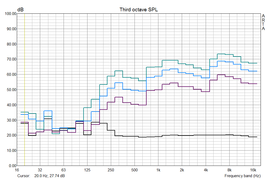
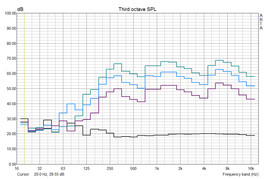
Energy Management
Power Consumption
The Apple MacBook Retina uses an 85-Watt MagSafe 2 power supply unit. The power adaptors from Apple are rather small for the application and get noticeably warm as a result, so you should not cover them with blankets or put them on sofas. The power consumption differs dramatically between Mac OS and Boot Camp Windows. The minimum consumption when idle under Mac OS is 7.6 Watts and therefore almost 10 Watts lower compared to 17.4 Watts under Windows. This is a sign that the integrated Intel Iris Pro 5200 Graphics is not used since Mac OS consumes up to 14 Watts with the integrated GPU and up to 18 Watts with the Nvidia GT 750M when idle. Another interesting aspect is the maximum power consumption, because it surpasses the nominal power output of the PSU. The power adaptor has to deliver 88.5 Watts, but the battery was not drained.
| Off / Standby | |
| Idle | |
| Load |
|
Key:
min: | |
Battery Runtime
The Apple notebook shuts down after 14:13 hours in our idle test, which is two hours shorter than the Dell XPS. Samsung's ATIV Book 8 manages 15 minutes more than the MacBook Pro Retina. We determine a more realistic runtime with our WLAN test that simulates web browsing via a script with websites and YouTube videos (a new website every 40 seconds). The situation changes and the Apple notebook can beat the Dell with 9:15 h by around 1:30 hours and the Samsung ATIV Book 8 by almost 2:30 hours. The Acer Aspire R7-571G cannot keep up with its rivals in this scenario and shuts down after 3:30 hours. The load test with Battery Eater (Classic Test) changes the situation once again and the Dell XPS 15 wins the battle by 30 minutes with 3:37 hours instead of 3:01 hours. Acer and Samsung clearly fall behind in this scenario. Overall, the MacBook manages great battery runtimes despite its thin construction and has no problems managing a normal business day. The Dell XPS can keep up with this performance and even beats the MacBook in two of three tests.
Verdict
So what do we get for 2,600 Euros (~$3538) and what not? We want to summarize the key aspects of this review.
The MacBook Pro 15 Retina can convince us with an almost impeccable build quality and the convenient haptics as well as design. The input devices leave nothing to be desired in terms of quality and the trackpad in particular is still one of the best mouse replacements. The keyboard could be improved with some special keys so you would not have to use Fn combinations. In terms of hardware, you get high-performance components that surpass or keep up with most rivals in the benchmarks. One drawback is still the enormous heat development and the poor maintainability of the MacBook. Apple provides excellent battery runtimes and the new 15-inch MacBook Pro Retina is no exception with great results.
Last but not least, we want to mention the most important component when we look at the designation – the display. Apple integrates a high-quality IPS panel with excellent measurement results and the Retina resolution of 2880x1800 pixels. Apple unfortunately does not offer a matte version of the panel. Even though the display is anti-reflective, it is hardly suited for outdoor environments.
Overall, we get a sophisticated notebook, which combines high-quality components in all areas. There are certainly less expensive alternatives for customers that can waive certain usage scenarios. For example, the Samsung ATIV Book 8 has similar hardware and costs half of the Apple notebook without an SSD and IPS display. The Dell XPS 15 in particular is an interesting rival with Windows for almost 600 Euros (~$817) less. The new MacBook Pro Retina does not show any innovations, but it is still an excellent notebook.


